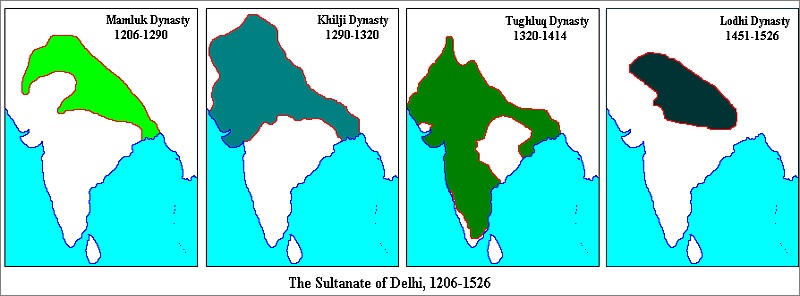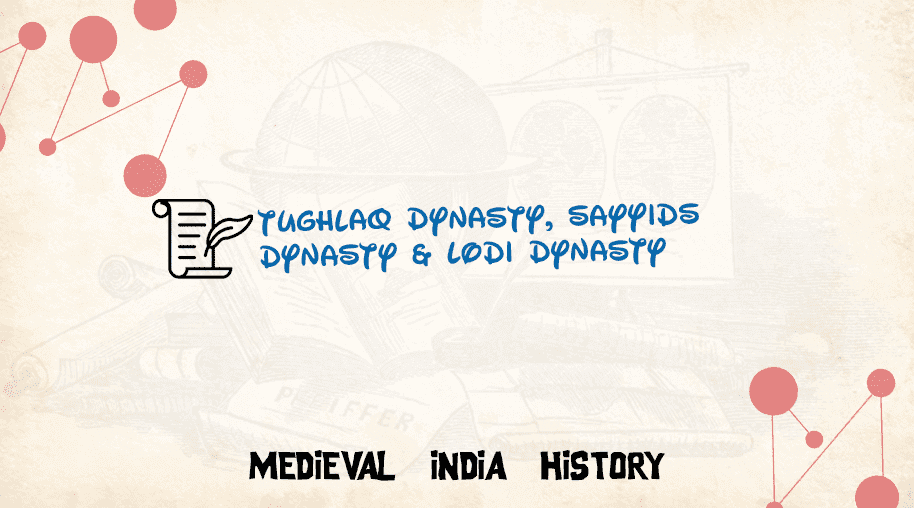Tughlaq Dynasty, Sayyids Dynasty & Lodi Dynasty
by Devender
0 1906
After the fall of the Khilji dynasty, 3 more dynasties emerged one after one in the Delhi Sultanate. The first one was the Tughlaq dynasty.
Tughlaq Dynasty
The Tughlaq dynasty was founded by Ghiyasuddin Tughlaq in 1320 and it ruled for 84 years till 1414. Ghiyasuddin Tughlaq also laid the foundation of Tughlaqabad near Delhi. He was murdered by his own son Ulugh khan. Later in 1325, his son claimed the throne under the name of Muhammad–bin–tughlaq.
- Muhammad–Bin–Tughlaq
- He introduced Copper coins in place of Silver Tanka
- Forgery couldn't be stopped so he had to stop the circulation of coins
- He then exchanged all the copper coins in the market with silver coins from the royal treasury
- It led to the vanishing of the royal treasury.
- Firoz Tughlaq
- Industry and Taxes:
- He developed royal factories known as Karkhanas where thousands of slaves were employed
- He also developed free hospitals & Marriage bureaus for poor Muslims
- Started a new department named Diwan–i–Khairat to take care of orphans and widows
- Art and Culture:
- Taimur entered Delhi after his death
- He looted everything by killing thousands of people
- Taimur left in 1399 and gave a death blow to the Tughlaq dynasty
- The last prince of this dynasty was Alam shah
- He was the weakest of them all
- He handed over the throne to Bahlol Lodi and retired to Badaun
- Sikander was succeeded by his son, Ibrahim Lodi
- He was very arrogant in nature
- He used to insult his nobles openly
- If any noble revolted, he put the noble to death
He was known for his tolerant nature towards religious matters and novel experiments. He became the only sultan who possessed a literary, religious & philosophical education. To control South India, he formed another capital at Devagiri under the name of Daultabad and forced people, Sufis, royals to move to Daultabad but many of them died due to the long and rigorous journey. So, after 2 years, he abandoned Daultabad and asked everyone to come back.
As a result, to get the treasury back, he imposed heavy tax revenue on land. The heavy taxes led to a revolt among peasants as a famine was already raging at that time.
Later, he launched another scheme named Takkavi loans which meant Loans for cultivation. The loans were given to farmers to buy seeds and extend their cultivation.
He also established a separate agricultural department known as Diwan–i–Kolhi. On his death, Barani quoted "Finally Sultan was freed from people & people from sultan". Barani also called him the mixture of opposites.
He appointed Khan-i-Jahan who was a Telugu brahmin before conversion as his kingdom's Wazir to take care of his day-to-day administration. He collected 1300 Sanskrit manuscripts from the Jwalamukhi temple and converted them into Persian.
He also revived the Iqta system and made it hereditary which allowed Noble's hereditary succession of their property. He had the largest slave people during his period which were known as Diwan-e-Bandagani.
He levied various taxes like Jiziya on Non-Muslims and also abolished taxes from 28 items as it was against Islamic law. He was the first sultan to impose irrigation taxes and he developed an irrigation network by means of canals. He encouraged horticulture a lot.
He developed 300 new towns near Red Fort in Delhi as Firozabad which are now known as Firozshah Kotla. He patronized scholars like Barani & Afif. He was intolerant towards Sufis & Shia Muslims and treated Hindus as second-grade citizens. He was guided by Ulemas.

Sayyids Dynasty
Before leaving, Taimur appointed Khirz khan as the governor of Multan. Khirz khan soon captured Delhi and founded the Sayyids Dynasty which ruled for around 37 years from 1414 to 1451.
Lodis Dynasty
Lodis were Afghanis and Bahlol Lodi became the first Afghan ruler of India. All his predecessors were Turks. He was succeeded by his son, Sikander Lodi. Sikander is known to be the greatest of all Lodis. He destroyed a lot of Hindu temples and imposed many restrictions on Hindus.
Daulat Khan Lodi was greatly displeased by Ibrahim Lodi's arrogance. So, he invited Babur to invade India. Babur marched on Delhi and killed Ibrahim Lodi in the First Battle of Panipat in 1526. This marked the end of the Delhi Sultanate.

Share:







Comments
Waiting for your comments